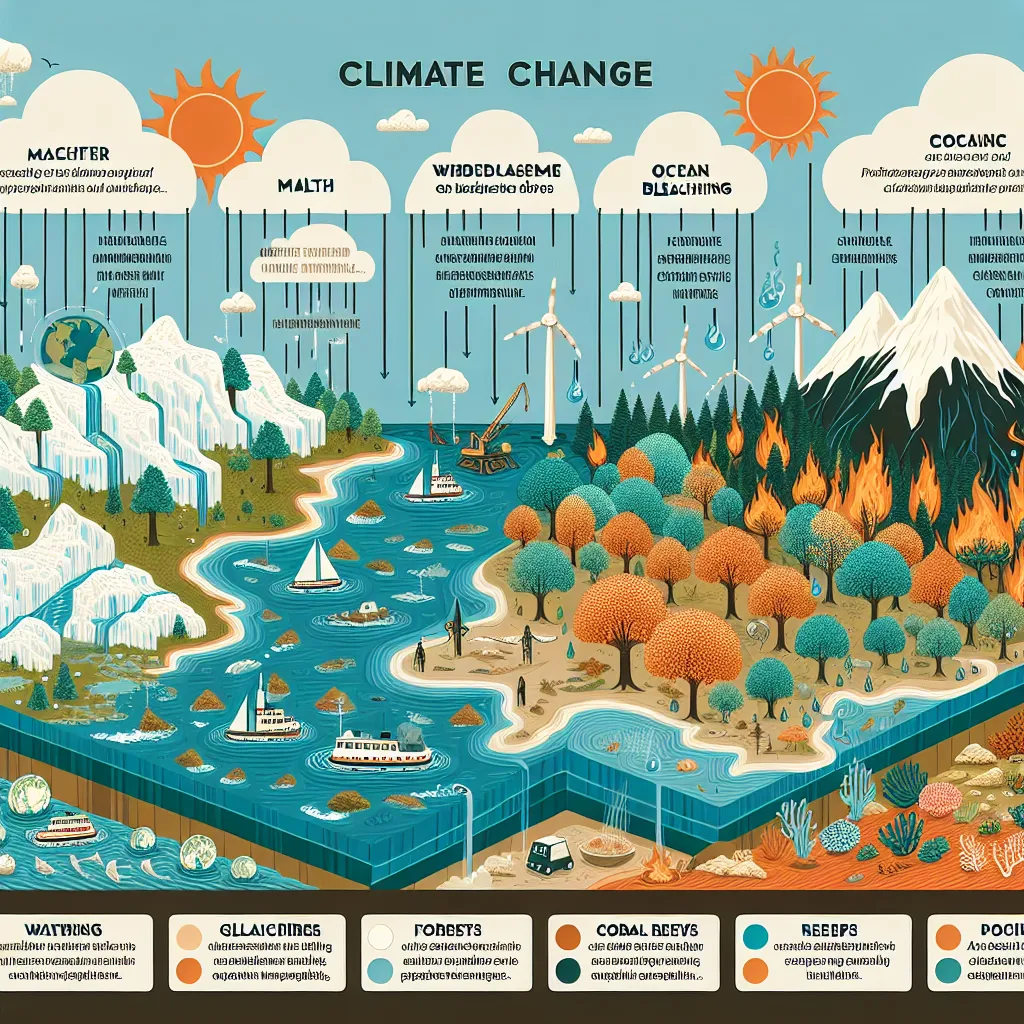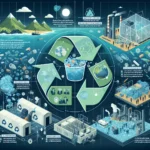The IELTS Reading section is a crucial component of the exam, testing your ability to comprehend complex texts and extract relevant information. One topic that has been increasingly prevalent in recent years is the effects of climate change on natural resources. This subject is not only timely but also highly likely to appear in future IELTS exams due to its global significance and ongoing relevance.
In this practice session, we’ll focus on a reading passage about the impacts of climate change on various natural resources. This topic combines elements of environmental science, economics, and social studies, making it an ideal candidate for the diverse and challenging texts found in IELTS Reading tests.
Reading Passage
Effects of Climate Change on Natural Resources
Climate change is one of the most pressing issues of our time, with far-reaching consequences for the planet’s natural resources. As global temperatures rise and weather patterns become increasingly erratic, ecosystems and the resources they provide are facing unprecedented challenges.
One of the most significant impacts of climate change is on water resources. Rising temperatures are causing glaciers to melt at alarming rates, affecting the water supply for millions of people who depend on glacial meltwater for agriculture and daily use. In addition, changing precipitation patterns are leading to more frequent and severe droughts in some regions, while others experience increased flooding. These shifts in water availability not only affect human populations but also have profound implications for aquatic ecosystems and the species that inhabit them.
Forests, another crucial natural resource, are also feeling the effects of climate change. Warmer temperatures and altered rainfall patterns are causing shifts in tree species distribution, with some species unable to adapt quickly enough to changing conditions. This can lead to forest die-offs and increased vulnerability to pests and diseases. Furthermore, more frequent and intense wildfires, exacerbated by climate change, are destroying vast areas of forest, releasing stored carbon into the atmosphere and further contributing to the cycle of global warming.
The world’s oceans, which cover more than 70% of the Earth’s surface, are not immune to the impacts of climate change. Rising sea temperatures are causing coral bleaching events, destroying these delicate ecosystems that support a wealth of marine biodiversity. Ocean acidification, caused by the absorption of excess carbon dioxide from the atmosphere, is making it difficult for shellfish and other calcifying organisms to form their protective structures. These changes ripple through marine food webs, affecting fish populations that millions of people rely on for food and livelihoods.
Soil, often overlooked but essential for agriculture and terrestrial ecosystems, is also being affected by climate change. Increased temperatures and changes in precipitation can alter soil moisture levels, affecting soil fertility and the ability to support crop growth. In some regions, more frequent and intense rainfall events are leading to increased soil erosion, washing away valuable topsoil and reducing agricultural productivity.
The impacts of climate change on natural resources are not isolated; they interact and compound one another, creating complex challenges for ecosystems and human societies alike. For example, changes in water availability can affect forest health, which in turn impacts soil quality and the habitats of countless species. This interconnectedness highlights the need for comprehensive approaches to addressing climate change and its effects on our planet’s vital resources.
As we grapple with these challenges, it is clear that urgent action is needed to mitigate the effects of climate change and adapt to the changes already underway. This includes reducing greenhouse gas emissions, developing more resilient agricultural practices, and implementing conservation strategies to protect vulnerable ecosystems. Only through concerted global efforts can we hope to safeguard our natural resources for future generations.
 Effects of climate change on natural resources
Effects of climate change on natural resources
Questions
True/False/Not Given
For questions 1-5, read the following statements and decide if they are True, False, or Not Given based on the information in the passage.
- Climate change is causing glaciers to melt, affecting water supply for agriculture and daily use.
- All tree species are equally affected by climate change.
- Ocean acidification is making it easier for shellfish to form their protective structures.
- Soil erosion due to climate change is reducing agricultural productivity in some regions.
- Governments worldwide have agreed on a unified approach to address climate change impacts on natural resources.
Multiple Choice
Choose the correct letter, A, B, C, or D for questions 6-10.
-
According to the passage, which of the following is NOT mentioned as an effect of climate change on forests?
A) Shifts in tree species distribution
B) Increased vulnerability to pests and diseases
C) More frequent and intense wildfires
D) Improved carbon sequestration -
What is causing coral bleaching events?
A) Ocean acidification
B) Rising sea temperatures
C) Increased marine biodiversity
D) Shifts in ocean currents -
How does climate change affect soil?
A) By increasing soil fertility in all regions
B) By altering soil moisture levels
C) By reducing the need for fertilizers
D) By eliminating soil erosion -
The passage suggests that the impacts of climate change on natural resources are:
A) Easily reversible
B) Isolated and independent
C) Interconnected and compounding
D) Beneficial for some ecosystems -
What does the author suggest is needed to address the effects of climate change on natural resources?
A) Focus solely on reducing greenhouse gas emissions
B) Ignore the changes and allow nature to adapt
C) Develop more resilient agricultural practices
D) Comprehensive approaches including emission reduction, agricultural adaptation, and conservation
Matching Headings
Match the following headings to the correct paragraphs in the passage. Write the correct number (i-viii) next to questions 11-14.
i. The overlooked resource: Soil and climate change
ii. Forests under threat
iii. The interconnectedness of climate change impacts
iv. Water resources in peril
v. Marine ecosystems at risk
vi. The need for global action
vii. Climate change: A pressing global issue
viii. Agricultural challenges in a changing climate
- Paragraph 2: _____
- Paragraph 3: _____
- Paragraph 4: _____
- Paragraph 6: _____
Answer Key and Explanations
True/False/Not Given
-
True – The passage states, “Rising temperatures are causing glaciers to melt at alarming rates, affecting the water supply for millions of people who depend on glacial meltwater for agriculture and daily use.”
-
False – The passage mentions that “some species [are] unable to adapt quickly enough to changing conditions,” implying that not all species are equally affected.
-
False – The passage states that ocean acidification is “making it difficult for shellfish and other calcifying organisms to form their protective structures.”
-
True – The passage mentions that “more frequent and intense rainfall events are leading to increased soil erosion, washing away valuable topsoil and reducing agricultural productivity.”
-
Not Given – While the passage discusses the need for action, it does not mention whether governments have agreed on a unified approach.
Multiple Choice
-
D – The passage does not mention improved carbon sequestration as an effect of climate change on forests.
-
B – The passage states, “Rising sea temperatures are causing coral bleaching events.”
-
B – The passage mentions that “Increased temperatures and changes in precipitation can alter soil moisture levels.”
-
C – The passage explicitly states that the impacts “interact and compound one another, creating complex challenges.”
-
D – The final paragraph suggests a comprehensive approach, including “reducing greenhouse gas emissions, developing more resilient agricultural practices, and implementing conservation strategies.”
Matching Headings
- iv – Water resources in peril
- ii – Forests under threat
- v – Marine ecosystems at risk
- iii – The interconnectedness of climate change impacts
Common Mistakes to Avoid
-
Overlooking key qualifiers: Pay attention to words like “some,” “many,” or “often” that may change the meaning of a statement.
-
Making assumptions: Stick to the information provided in the text and avoid drawing conclusions based on your own knowledge.
-
Misinterpreting Not Given: Remember that Not Given means the information is neither confirmed nor contradicted by the passage.
-
Rushing through the passage: Take time to understand the main ideas and structure of the text before attempting the questions.
-
Ignoring context: Consider the surrounding sentences when answering questions about specific details.
Vocabulary
- Erratic (adjective): /ɪˈrætɪk/ – unpredictable; not consistent or regular
- Unprecedented (adjective): /ʌnˈpresɪdentɪd/ – never done or known before
- Exacerbate (verb): /ɪɡˈzæsəbeɪt/ – make (a problem, bad situation, or negative feeling) worse
- Biodiversity (noun): /ˌbaɪəʊdaɪˈvɜːsəti/ – the variety of plant and animal life in the world or in a particular habitat
- Calcifying (adjective): /ˈkælsɪfaɪɪŋ/ – to make or become hard or stony by the deposit of calcium salts
- Ripple (verb): /ˈrɪpl/ – to spread gradually through a system, organization, or group of people, causing a gradual change
- Compound (verb): /kəmˈpaʊnd/ – make (something bad) worse; intensify the negative aspects of
- Mitigate (verb): /ˈmɪtɪɡeɪt/ – make less severe, serious, or painful
Grammar Focus
Pay attention to the use of present continuous tense to describe ongoing effects of climate change:
- “Climate change is causing…”
- “Rising temperatures are causing…”
- “These shifts in water availability not only affect… but also have…”
This tense emphasizes the current and continuing nature of these impacts.
Also, note the use of conditional structures to discuss potential future scenarios:
- “Only through concerted global efforts can we hope to safeguard our natural resources for future generations.”
This structure (Only + condition + can/will + result) is used to emphasize the necessity of the condition.
Tips for IELTS Reading Success
-
Practice active reading: Engage with the text by underlining key points and making mental summaries as you read.
-
Improve your vocabulary: Regularly learn new words and phrases related to common IELTS topics like environment, science, and social issues.
-
Time management: Allocate your time wisely between reading the passage and answering questions. Don’t spend too long on any single question.
-
Skim and scan effectively: Use these techniques to quickly locate specific information in the text.
-
Read the instructions carefully: Make sure you understand what each question is asking before attempting to answer.
-
Use contextual clues: If you encounter unfamiliar words, try to guess their meaning from the surrounding context.
-
Practice regularly: Consistent practice with various question types and passages will improve your speed and accuracy.
Remember, success in IELTS Reading comes from a combination of strong English language skills, effective test-taking strategies, and familiarity with a wide range of topics. Keep practicing and stay informed about global issues like climate change, as these are likely to appear in future IELTS exams.
For more practice on related topics, check out our articles on climate change’s impact on economic stability and climate change’s effect on global weather patterns.


